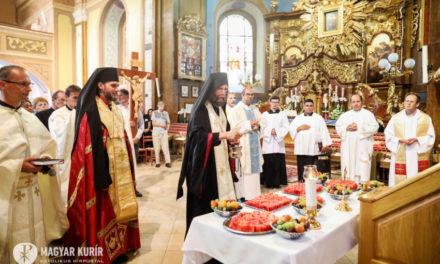The complete renovation of the Cathedral of Our Lady in Győr since 2017 has been completed; the church was re-consecrated by Győr county bishop András Veres, president of the Hungarian Catholic Bishops' Conference, on Wednesday as part of a holy mass.
During the development of more than 4 billion forints, the majority of which was realized from state funds, the facade of the main church was renewed, the tower was modernized, and new bells were added to it. The ceiling fresco and the baroque wall paintings were restored, the main and side altars of the cathedral and the gallery were renovated.
In the second half of the 20th century, the church was replaced with limestone paving. The building engineering, lighting, heating, security and sound systems were modernized. A perpetual worship chapel and treasury were created in the cathedral, where the sacred treasures of the cathedral will be kept in the future.
At the Mass, András Veres spoke about: the most important common prayer of Christian people is the Mass, and the most important place is the church, where they can gather to celebrate the Eucharist. He emphasized: cathedrals have a decisive role in the life of the church. The seat of the bishop appointed by the pope indicates that the church operates in an organized manner in "communion with Rome" in the given area.
At the same time, each cathedral is also the self-expression of the given region: it is indicative of the way in which the church is valued, he said.
We Győrs are proud of our church
said the head pastor. They are proud of the fact that the cathedral has the image of the Virgin Mary shedding blood, the herm of St. László and the grave of Bishop Vilmos Boldog Apor, who died a martyr's death in 1945. He added: the people of Győr would like the faithful who enter their cathedral to always find a place to pray, and that many non-believers would also find communion with God here.
András Veres finally thanked the government for supporting the renovation, indicating that the church renovation would have been unthinkable without this effective help. "I believe - said the head pastor - that the renovation not only supported the faithful of the Diocese of Győr, not only the faithful from Hungary who make regular pilgrimages to the icon", but also strengthened the image of Hungary through people coming from Europe or even further away.
András Veres placed the relics of St. László and Boldog Vilmos Apor in the altar during the rededication. Zsolt Semjén, Deputy Prime Minister responsible for churches, and Miklós Soltész, State Secretary of the Prime Minister's Office responsible for church and ethnic relations, took part in the Holy Mass. The foundations of the Győr Cathedral were laid in the time of Saint Stephen.
Retrospective
In its first form, the church was built in the Romanesque style in the 11th century, from this period only the apse of the church has survived to the present day. After the Tatar invasion, it was rebuilt in the Gothic style. At the beginning of the 15th century, Bishop János Héderváry had a chapel built next to the nave on the right, where the herm of Saint László is kept today. In the second half of the century, the Gothicization of the entire church began.
The church was badly damaged in the first half of the 16th century, especially after the appearance of the Turks in Győr in 1529, one of its towers fell. The other tower was destroyed by lightning in the 1580s. The cathedral, which was completely ruined, was rebuilt in the early Baroque style between 1639 and 1645 on the orders of Bishop György Draskovich, based on the plans of the Italian architect Giovanni Battista Rava. The current braid-style tower of the church was commissioned by Bishop György Széchényi in the 1680s. The final design of the church interior was completed in the 1780s based on the plans of Menyhért Hefele. Austrian painter Franz Anton Maulbertsch created the frescoes covering the walls and ceiling.
MTI
Featured image: The renovated Assumption Cathedral in Győr on the day of the rededication, September 13, 2023. The complete renovation of the church has been completed, which was realized with more than HUF 4 billion, mostly from state funds. MTI/Csaba Krizsán













